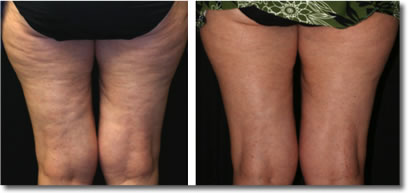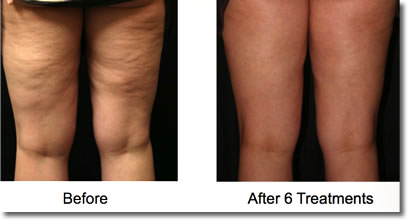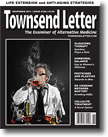|
Cellulite is a chronic condition that affects 80% to 90% of women and has a measured effect on the quality of life.1 Cellulite is a common affliction in which the skin acquires an "orange peel" appearance, usually in the thigh and buttock areas. Cellulite appears due to alterations that occur in the adipose tissue and the microcirculation as a result of blood and lymphatic disturbances, causing fiberosclerosis of the connective tissue.
Treatment options for cellulite are vast in number and vary widely in effectiveness. This article will focus on the physiological manifestation of cellulite, its causes, symptoms, and a novel treatment option.
What is Cellulite?
Cellulite is a common term utilized to describe a condition where superficial pockets of trapped fat cause uneven dimpling of the skin, resulting in an "orange peel" or "mattress" appearance. It appears in 90% of postadolescent women and is rarely seen in men. Cellulite is most commonly found in the thigh, buttock, and abdominal areas. Contrary to popular belief, there is not a direct association between obesity and cellulite, and it affects women of all shapes and sizes.
Formation of Cellulite
Three fat layers lie beneath the epidermis and dermis. Cellulite develops in the most superficial of these layers, known as the hypodermis or subcutaneous fat layer. This layer is unique because the fat lobules are organized into "pockets" by surrounding strands of connective tissue. Fat storage and metabolism in the subcutaneous layer are regulated by hormones, rather than diet and exercise. The cells of the reserve layers of fat beneath the subcutaneous fat layer are arranged in a loose configuration. Fat storage and metabolism in these two layers is determined by genetics and influenced by diet and exercise. These layers do not contribute to the formation of cellulite.2
The formation of cellulite is a result of many cellular processes. In the adipose tissue, fat cells swell due to fat storage. These clusters of swollen fat are bound by collagen fibers that stiffen, pulling down on their points of attachment. Meanwhile, capillary walls become more permeable, causing localized fluid accumulation, while inadequate lymphatic drainage slows down the removal of excess fluid. These changes in blood flow, lymphatic drainage, fat, and connective tissue result in the dimpled appearance known as cellulite.
Microcirculation imbalance imposes a vicious cycle in the development of cellulite. When there is inadequate microcirculation, lymphatic and blood flow decreases. Additionally, the increase in fat accumulation causes higher pressure in the tissues, leading to lowered circulation. This poor microcirculation reduces fat tissue metabolism, yielding lymphatic substances into the tissue. The venous arterial reflux breaks down, leading to edema. At this point, muscle contraction is no longer enough for adequate blood and lymph circulation. This slow circulation causes lipogenesis. The less blood and lymphatic circulation, the less fat catabolism occurs, causing even more cellulite.
At this stage, cellulite can develop from a cosmetic problem into a medical condition known as lipedema. This advanced stage of cellulite is characterized by the inability of the lymphatic vascular system to return adequate proteins and lipids from the interstitial space. This increased concentration of plasma proteins, lipids, and degradation products in the interstitial space causes fibrosis, altering tissue properties.3
There are many factors affecting the onset of cellulite, including lifestyle, hormones, and aging. Cellulite forms as a result of complex physiological changes to the subcutaneous fat layer, despite attempts to exercise regularly and follow a well-balanced diet. However, an unhealthful lifestyle (poor diet, sedentary lifestyle, smoking, alcohol consumption) can change the overall appearance of existing cellulite, and not in a positive fashion. Hormonal factors have a significant importance in the development of cellulite, since cellulite develops mainly in women during periods of hormonal change, such as puberty, pregnancy, menopause, and so on. Hormones are responsible for the regulating changes in blood flow, lymphatic drainage, fat, and connective tissue, all of which play a role in cellulite formation. Aging itself results in the loss of skin tone and thickness in the dermal and superficial fat layers, resulting in cellulite that is more visible due to volume loss.4
Classification of Cellulite
Two ways to measure the appearance of cellulite are the pinch test and the Nurnberger-Muller Scale. The pinch test is the simplest way to locate cellulite by simply pinching the skin in the thigh or buttock area in between the thumb and index finger and looking for dimpling.
The Nurnberger-Muller Scale classifies cellulite based on a four-stage scale5:
- Stage 0: no dimpling when standing and lying; pinch test shows no orange peel appearance
- Stage 1: no dimpling when standing or lying; pinch test reveals orange peel appearance
- Stage 2: dimpling appears when standing and not lying down
- Stage 3: dimpling appears when both standing and lying down
The Treatment of Cellulite
Effective treatments for cellulite accomplish the following: reduce lipedema, restore microcirculation, restructure and protect connective tissue, and promote lipolysis. Once such treatment involves acoustic wave therapy (AWT).
AWT originated as shock wave technology, which has been used for over 30 years in urology and is better known as ESWL (extracorporeal shock wave lithotripsy). The main difference between ESWL and AWT is that a much lower intensity shock wave is used with the goal of stimulating the tissue's healing and regeneration processes as opposed to destruction. AWT involves the delivery of mechanical energy to the skin's surface into the subcutaneous tissue, stimulating the cells, causing an increase in microcirculation and metabolism, as well as the activation and release of messenger substances.6
The following effects of acoustic waves have been observed in aesthetic medicine and have been validated via animal trials: increase of cell wall permeability, stimulation of lymph and blood microcirculation, release of nitric oxide (vasodilation, increased cell metabolism, neoangiogenesis, anti-inflammatory effect), and stimulation of growth factors and stem cells.7-9
The treatment of cellulite utilizing AWT involves a series of 6 to 12 treatments once or twice per week. An average treatment delivers 2000 pulses per 10 by 15 centimeter treatment area. Ultrasound gel is used with the device for coupling, and the treatment is described as a very vigorous massage. Redness and erythema are common endpoints; these symptoms dissipate very quickly posttreatment. Posttreatment instructions include increased water intake, regular exercise, and minimal consumption of saturated fat and carbohydrates. Patients should avoid NSAIDs during treatment and can return to regular activity immediately. Contraindications include pregnancy, breast-feeding, phlebitis or deep vein thrombosis, cancer, and renal/hepatic insufficiency.
Treatment with AWT results in an increase in blood flow due to massage, vasodilation, and angiogenesis; removal of water and waste products due to lymphatic drainage; mechanical and biochemical lipolysis; softening of fibrotic structures; strengthening of connective tissues (collagen neogenesis) resulting in increased skin elasticity and firmness; and cell regeneration.10 This treatment is not just limited to cellulite, but is also effective for wound healing, skin smoothing, scar reduction, and stretch mark reduction.


Clinical Studies
Statistically significant effects on improved cellulite appearance and increased skin elasticity have been shown in clinical studies.4,10,11,13 Christ et al. treated 59 women with advanced cellulite. Fifteen patients received planar acoustic wave treatments for six sessions over three weeks; the second group of 44 patients received eight sessions over four weeks. Connective tissue changes were measured using ultrasound, skin elasticity was evaluated using a vacuum probe measurement device, and photographs were taken for evaluation. Skin elasticity values revealed a 73% increase at the end of six months of treatment. At three- and six-month follow-ups, skin elasticity improved by 95% and 105% respectively.4
Siems et al. took in vivo measurements in 26 female patients with lipedema and cellulite before and after AWT treatment. Oxidative stress parameters of blood serum and biomechanic properties of the dermal surface were evaluated. Oxidative stress in lipedema and cellulite was demonstrated by increased serum malondialdehyde (MDA) and plasma protein carbonyls compared with control. Both MDA and protein carbonyls decreased after serial acoustic wave treatments. Acoustic therapy also improved the appearance of cellulite in the subjects. Based on these findings, the release of lipid peroxidation products from edematous dermis is an important effect of AWT in lipedema and cellulite.11
AWT is currently FDA approved in the US for the treatment of orthopedic conditions and is used off-label as a cellulite treatment. FDA trials are under way for the treatment of cellulite, and approval is expected in 2012.
Conclusion
Cellulite is a chronic condition that is multifactorial in nature. Cellulite is associated with reduced transport capacity of lymphatic vessels. In lipedema, the lymphatic system is no longer able to return adequate protein molecules from the interstitial space into the venous system. This concentration of plasma proteins causes fibrosis and alters the tissue properties. The effects of AWT on tissue include the stimulation of microcirculation and improvement in cell permeability. Additionally, the collagen and elastin fibers in the dermis and subcutaneous tissue become denser and firmer. The serum examinations conducted thus far suggest that oxidative stress in the affected area is reduced, leading to collagen synthesis. No clinically relevant side effects have been observed in clinical studies to date. The measured parameters of the mechanical skin properties and patient satisfaction are very promising in terms of long-term effectiveness.

Notes
1. Avram MM. Cellulite: a review of its physiology and treatment. J Cosmet Laser Ther. 2004;6:181–185.
2. Avram MM et al. Subcutaneous fat in normal and diseased states: 1. Introduction. J Am Acad Dermatol. 2005;53:663–670.
3. Rossi AB, Vergnanini AL. Cellulite: a review. J Eur Acad Dermatol Venereol. 2000;14:251–262.
4. Christ C et al. Improvement in skin elasticity in the treatment of cellulite and connective tissue weakness by means of extracorporeal pulse activation therapy. Aesth Surg J. 2008;28:538–544.
5. Draeolos ZD. The disease of cellulite. J Cosmet Dermatol. 2005;4: 221–222.
6. Wess O. Physics and technology of shock wave and pressure wave therapy. MOT. 2005;5:7–32.
7. Byron CR et al. Effects of radial shock waves on membrane permeability and viability of chondrocytes and structure of articular cartilage in equine cartilage explants. Am J Vet Res. 2005;66(10):1757–1763.
8. Mariotto S et al. Extracorporeal shock waves: from lithotripsy to anti-inflammatory action by NO production. Nitric Oxide. 2005;12:89–96.
9. Chan YJ et al. Recruitment of mesenchymal stem cells and expression of TGF-β1 and VEGF in the early stage of shockwave promoted bone regeneration of segmental defects in rats. J Ortho Res. 2003;11:1117–26.
10. Anghern F et al. Can cellulite be treated with low-energy extracorporeal shock wave therapy? Clin Interv Aging. 2007;4:623–630.
11. Siems W et al. Anti-fibrotic effects of shock wave therapy in lipedema and cellulite. Biofactors. 2005;24:275–282.
12. Russe E et al. Acoustic wave treatment for cellulite – a new approach. ASLMS Congress. Washington, D.C.;2009.
13. Christ C et al. Boosting skin elasticity and revitalizing the dermis in cellulite and connective tissue weakness by means of extracorporeal acoustic wave therapy (AWT ). Aesth Dermatol. 2008;1:120–126.
 Sharon McQuillan, MD, is a board-certified physician who specializes in aesthetic, anti-aging, and regenerative medicine. She founded the Ageless Aesthetic Institute, a level 4 ACCME-accredited aesthetic training program for medical professionals, in order to standardize and elevate the practice of aesthetic medicine. Dr. McQuillan has educated thousands of medical professionals in the art and science of aesthetic and anti-aging treatments for over a decade. She lectures internationally on aesthetic and regenerative medicine for many organizations and is the medical director of the Aesthetic Fellowship, hosted by the American Academy of Anti-Aging Medicine. Dr. McQuillan owns and operates the Ageless Institute in Aventura, Florida, offering anti-aging, aesthetic, regenerative, and weight loss treatments. In 2009, Dr. McQuillan formed the Ageless Regenerative Institute in conjunction with a team of experts in stem cell therapies. This team has developed an approved method and protocol for the harvesting and isolation of adipose-derived stem cells for autologous transplantation. Sharon McQuillan, MD, is a board-certified physician who specializes in aesthetic, anti-aging, and regenerative medicine. She founded the Ageless Aesthetic Institute, a level 4 ACCME-accredited aesthetic training program for medical professionals, in order to standardize and elevate the practice of aesthetic medicine. Dr. McQuillan has educated thousands of medical professionals in the art and science of aesthetic and anti-aging treatments for over a decade. She lectures internationally on aesthetic and regenerative medicine for many organizations and is the medical director of the Aesthetic Fellowship, hosted by the American Academy of Anti-Aging Medicine. Dr. McQuillan owns and operates the Ageless Institute in Aventura, Florida, offering anti-aging, aesthetic, regenerative, and weight loss treatments. In 2009, Dr. McQuillan formed the Ageless Regenerative Institute in conjunction with a team of experts in stem cell therapies. This team has developed an approved method and protocol for the harvesting and isolation of adipose-derived stem cells for autologous transplantation.


|
|



![]()
![]()
![]()



 Sharon McQuillan, MD, is a board-certified physician who specializes in aesthetic, anti-aging, and regenerative medicine. She founded the Ageless Aesthetic Institute, a level 4 ACCME-accredited aesthetic training program for medical professionals, in order to standardize and elevate the practice of aesthetic medicine. Dr. McQuillan has educated thousands of medical professionals in the art and science of aesthetic and anti-aging treatments for over a decade. She lectures internationally on aesthetic and regenerative medicine for many organizations and is the medical director of the Aesthetic Fellowship, hosted by the American Academy of Anti-Aging Medicine. Dr. McQuillan owns and operates the Ageless Institute in Aventura, Florida, offering anti-aging, aesthetic, regenerative, and weight loss treatments. In 2009, Dr. McQuillan formed the Ageless Regenerative Institute in conjunction with a team of experts in stem cell therapies. This team has developed an approved method and protocol for the harvesting and isolation of adipose-derived stem cells for autologous transplantation.
Sharon McQuillan, MD, is a board-certified physician who specializes in aesthetic, anti-aging, and regenerative medicine. She founded the Ageless Aesthetic Institute, a level 4 ACCME-accredited aesthetic training program for medical professionals, in order to standardize and elevate the practice of aesthetic medicine. Dr. McQuillan has educated thousands of medical professionals in the art and science of aesthetic and anti-aging treatments for over a decade. She lectures internationally on aesthetic and regenerative medicine for many organizations and is the medical director of the Aesthetic Fellowship, hosted by the American Academy of Anti-Aging Medicine. Dr. McQuillan owns and operates the Ageless Institute in Aventura, Florida, offering anti-aging, aesthetic, regenerative, and weight loss treatments. In 2009, Dr. McQuillan formed the Ageless Regenerative Institute in conjunction with a team of experts in stem cell therapies. This team has developed an approved method and protocol for the harvesting and isolation of adipose-derived stem cells for autologous transplantation.